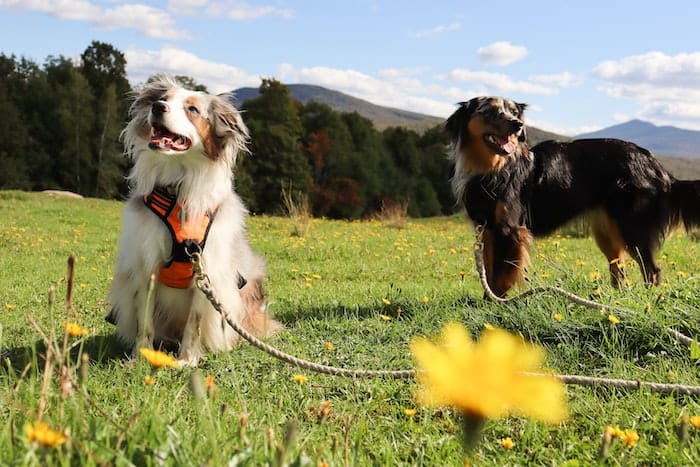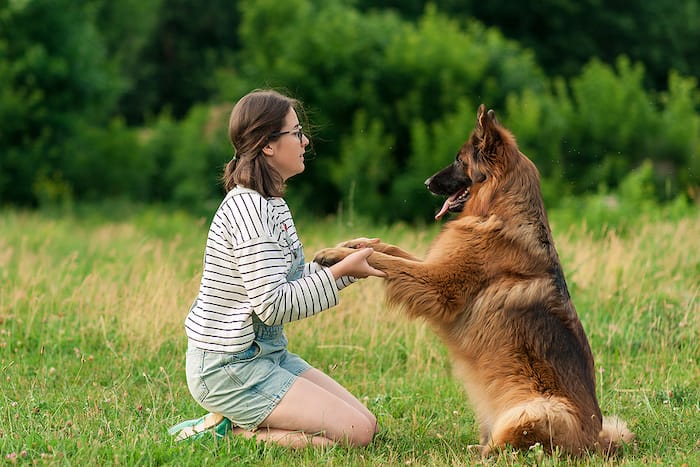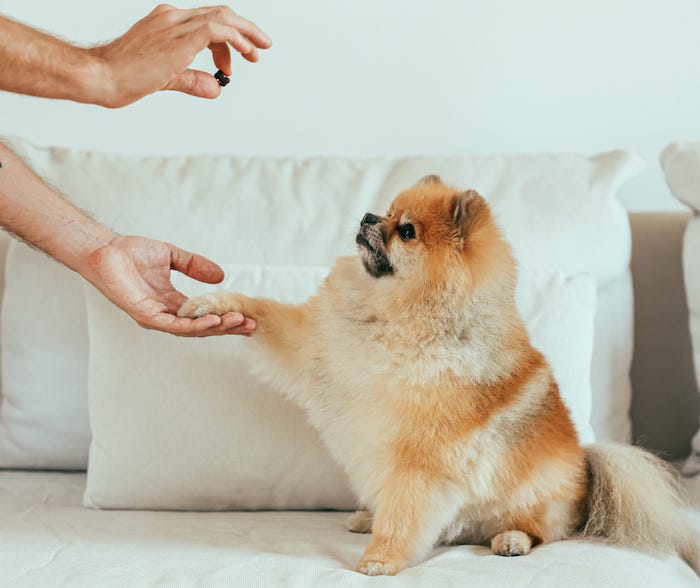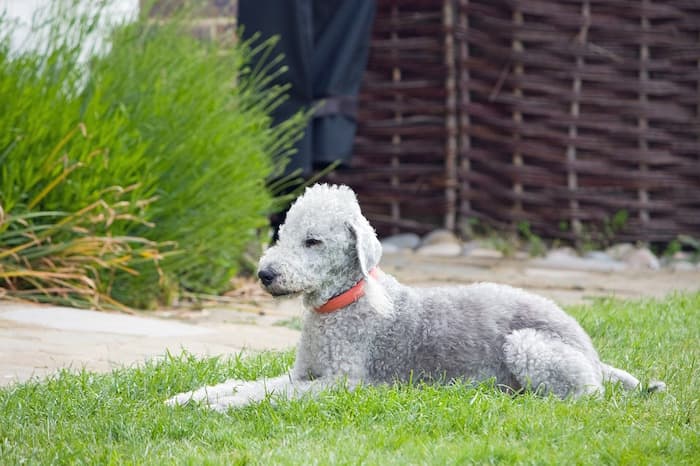Training is a crucial step in getting a puppy or rehoming a dog, and positive reinforcement dog training is the only training you should be focused on. I’ve positively reinforced my dogs from the day that they came home, and it is the only type of training they will actually listen to.
Your dog is now a part of your family, and if you want it to behave a certain way, then you first need to go through your own training, learning all the ins and outs of positive reinforcement and the ways you can train your dog to only display desired behaviors.
Now, no one said training a dog is easy, and it is going to take a lot of patience, time, and dedication, but trust me, once your pup is sitting on command, leaving on command, and listening to what you want them to do, you’ll feel accomplished and proud of not only your pup but also yourself. So, are you ready to get started?
What Is Positive Reinforcement Training?
In simple terms, positive reinforcement training is science-based dog training where you reward your dog for positive behaviors. For example, if your dog sits when you ask them to, you reward them with a treat, a toy, attention, or a game.
The reward you give your dog will vary from dog to dog, as some dogs are food-motivated, and others just love a scratch on the head. My dogs are very food-motivated, so yummy treats really work best for us.
By giving your dog a reward after they perform a desired behavior, your dog associates that behavior with something positive. Once they clock on to the fact that these behaviors result in a treat, they will soon begin to increase the positive behaviors.
With the increase in positive behaviors also comes the decrease in negative behaviors like chewing the couch, biting ankles, or eating things they shouldn’t. So after some time, slowly but surely, the negative behaviors will fizzle out, and your sanity will be restored. Sounds totally worth it, doesn’t it?
Dog owners often, without even thinking about it, reward their pets for unwanted behavior; I know I’ve accidentally done it a few times when my dog barks. You see, one of my dogs is a barker, he is a Dachshund, after all, and whenever someone walks past our house, he inevitably barks.
If I’m stressed or occupied with something else, I will call his name, which just encourages the behavior even further. We’re working on the “quiet” command with a treat as a reward, but let me tell you, it’s a work in progress, and although my patience is being tested, I know we’ll get there in the end.
Four Quadrants of Training
The American Kennel Club explains how there are four quadrants to operant conditioning, which is the method of learning and modifying behaviors by using rewards and punishment.
The four quadrants are positive reinforcement, positive punishment, negative reinforcement, and negative punishment.
- Positive reinforcement: Adding something like a treat to positive behaviors to encourage your dog to do them more often.
- Positive punishment: Adding something your dog dislikes, like a gentle smack on the rump, to reduce their desire to perform unwanted behaviors.
- Negative reinforcement: Taking something unpleasant away to make desired behaviors more frequent. For example, letting the pressure go on a choke chain when your dog complies with what you’re asking them to do.
- Negative punishment: Taking away something your dog likes, like your attention, to decrease negative behaviors.
When you’re training your dog, you should mainly focus on positive reinforcement, but negative punishment can also be effective in reducing unwanted behaviors.
Using positive punishment and negative reinforcement can put your dog off training completely while also shattering the bond between you and them. Put it this way, would you be more inclined to perform a task if a bar of chocolate was involved or a smack on your bum?
Timing Of Training
When training with positive reinforcement, you need to be on the ball and ready to go at all times because the reward must come the second your dog performs the task you want them to do.
If you ask your dog to sit, and they do it, reward them instantly, not when they’ve stood back up, as in their minds, standing back up was the thing you were rewarding them for.
Keep The Training Short
Training methods like positive reinforcement training are best and most effective when you do them consistently over short periods. I personally like to carve out 15 minutes once or twice a day so my dog doesn’t get overwhelmed or bored with the process.
It’s also important to teach your dog only one thing during any given training session. When your dog is first learning to sit, for example, you don’t want to use that 15 minutes to teach them to sit, down, stay, and leave it. Focus only on sitting until they’ve learned that command, and then move on to something else.
Most Common Verbal Cues
Your dog is smart, but they don’t understand long sentences, so when you’re working on positive reinforcement training, stick to single, common words and say them with a calm voice.
Common verbal cues:
- Sit
- Down
- Stay
- Off
- Come
- Up
- Leave it (if you don’t want them to pick something up)
- Drop (if they have something you don’t want them to have)
- Heel (if you want them to walk close to your side)
Using common cues makes it easy for your dog to understand what you want them to do, and it also means other people who come close to your dog can command them the same way you would.
There is a dog I’ve seen on Tiktok whose name is Sirius, and when his owner wants him to go into his crate, she says, “Azkaban.” I’m sure all Harry Potter fans love this; I know I did.
So once you’ve taught your dog the basic commands, then, of course, you can get fun with it like Sirius, but when you’re just getting started, keep it short and sweet.
Consistency
Consistency is key, so make sure that everyone in your family knows what cues to use and the ways they should reward your dog’s behavior. As I mentioned before, schedule a couple of 15-minute training sessions a day, and your dog should pick up commands in no time.
Benefits Associated With Positive Reinforcement Training
Positive reinforcement teaches your dog how to behave, but it also helps build confidence, and combat fear, and it creates a stronger bond between you and your pooch.
Some of the benefits that come with positive reinforcement training include:
- Shaping behavior
- Building confidence
- Rewarding your dog for good behavior
- Combating fear in dogs
- Anticipating good learning behavior
- Creates strong bonds between dog and owner
When To Use Positive Reinforcement
Dog training can be tricky, and it’s important that you understand when to reward your dog and when not to reward your dog. You don’t want to be encouraging them to do something unwanted now, do you?
The Good
Reward your dog to reinforce the good behavior that they have just displayed. For example, ask your dog to sit before letting them outside, petting them, putting them on their leash, or before feeding them.
Rewarding them will stop them from dashing out the door and jumping up on people. It will also teach them that they need to be calm before an ever-so-exciting walk and how to have manners at mealtime.
The Bad
Things you wouldn’t see as a reward can be a reward in your dog’s eyes. For example, if your puppy is biting your ankles, and you start to run away from them, they see it as a game, which then encourages them to bite your ankles even more.
Instead, if your dog is biting your ankles, have them perform a desired behavior, like sit, and reward them. This will teach them that good behaviors get treats and bad behaviors get nothing.
Things You’ll Need for Positive Reinforcement Training
To begin your dog training journey, you’ll need the following:
- A dog collar and a dog harness: Collars and harnesses shouldn’t pinch or tighten around your dog, and if you’re training in the outdoors, then one with a GPS and a stimulus telling your dog to stop when it reaches a certain boundary, like the Halo Dog Collar really comes in handy.
- A leash: Preferably one that is four to six feet long.
- Plenty of treats: Moist and meaty work best.
You could also purchase a dog clicker and a crate to help potty train your dog and keep them safe when they’re home alone.
What Are The Different Types Of Rewards?
Each dog is different, and some might react better to praise and attention, whereas others will learn faster with food. As most dogs are food-motivated, incorporating treats into your training will be your best bet.
PetMD recommends something moist and meaty for a treat, and it should be roughly the size of a pea. You may find that your dog gets bored of the same treat over and over, so you might need to keep a variety of treats on hand to keep them engaged and willing to learn.
Pair treats with verbal praise like the word “yes” so they know that they’re performing good behaviors that are making you happy.
When Should Treats Be Given?
When your dog is first learning a new behavior or command, reward them with a treat and verbal praise every time they complete the behavior to continuously reinforce them. Once they have learned the behavior, you can then start to reinforce them intermittently by giving them a treat four out of five times.
Over time, slowly decrease the number of treats you’re giving them so you’re only rewarding them occasionally. With that being said, always make sure that every time they perform the behavior, you reward them with verbal praise, so after a while, they will be working only for verbal praise.
Will Treats Always Encourage Dogs To Beg For Food?
Rewarding your dog with treats during training sessions won’t encourage dogs to beg for food because they know that they’re working for a reward by completing positive tasks, not begging.
How To Use Positive Reinforcement If The Dog Is On A Special Diet?
If a dog is on a special diet, then you can use their typical meal during training sessions. For example, instead of giving your dog its dinner in a bowl, hand it out in chunks as rewards for desired behavior.
What Rewards Are Used By Professional Dog Trainers?
Professional dog trainers are likely to use high-value treats as a reward, but as I’ve mentioned before, all dogs are different, so trainers may also use petting, praise, and games to encourage a dog to perform different commands.
Put it into your perspective, would you work harder for something you love or just something that’s okay at best?
When Does Positive Reinforcement Not Work?
Positive reinforcement doesn’t work if the reward you’re giving them is available when they aren’t acting out a positive behavior, if you don’t consistently give them a reward when they are first learning a new command, or if the same reward is overused when training.
Conclusion
Dogs trained with positive reinforcement are far more likely to pick up and consistently use positive behavior. It does take time, and it may at first seem like your dog isn’t listening, but with dedication, your pooch will soon be behaving the way you want them to.
Related Reading




